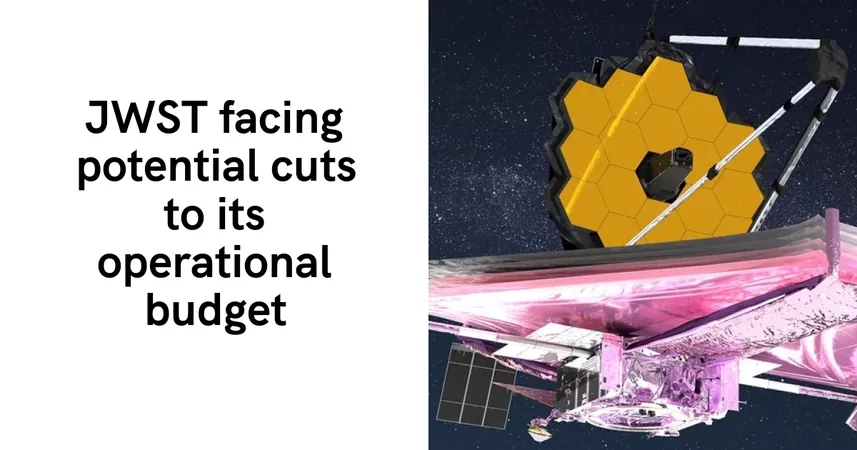
James Webb Space Telescope Faces Possible Budget Crisis: What This Means for the Future of Space Exploration
2025-01-25
Author: Lok
James Webb Space Telescope Faces Possible Budget Crisis: What This Means for the Future of Space Exploration
In a concerning turn of events for the scientific community, the James Webb Space Telescope (JWST), which has been a game-changer in astronomical research, might soon face significant cuts to its operational budget. Although JWST has consistently surpassed expectations since its launch, officials from the Space Telescope Science Institute (STScI) warn that financial constraints could limit its effectiveness as early as this fall.
Currently navigating its five-year prime mission, JWST is enjoying unprecedented demand for observing time, with scientists eager to harness its advanced capabilities. Jennifer Lotz, director of STScI, recently attested at the 245th Meeting of the American Astronomical Society that the telescope is “performing better than expected,” a sentiment echoed by JWST project scientist Macarena Garcia Marin, who noted the telescope's sharp images and heightened sensitivity of its instruments. “In a nutshell, it is truly fulfilling its promise of revolutionizing science,” she stated.
With a designed lifespan of a decade, JWST’s propulsion system could last more than 20 years, paving the way for it to potentially operate into the 2040s and work alongside future projects like the Habitable Worlds Observatory, slated for launch in the early 2040s. This extension of service offers astronomers exciting possibilities for deepening our understanding of the universe.
However, the financial outlook is less rosy. NASA’s proposed budget for fiscal year 2025 includes $187 million for JWST, comprised of $127 million for operations and $60 million in science grants. Unfortunately, the budget is projected to remain stagnant through 2029, raising alarms among astronomers about the sustainability of JWST's operations amidst rising costs and inflation.
Tom Brown, from the JWST mission office at STScI, highlighted the discrepancy between initial budget estimates and current realities, stressing that costs were set too low during mission planning. This has led to a potential operational budget cut of around 20%, which could come into effect as soon as October 2025. The impact of such a reduction could be severe, hindering scientific productivity and limiting essential support for astronomers, as well as potentially affecting instrument capabilities and maintenance.
At the recent town hall, astronomers voiced significant concerns over these budget cuts. “It’s extremely worrisome that, while we’re in the middle of the prime mission, we’re also maybe looking at significant budget cuts,” Brown remarked, emphasizing the profound repercussions of a 20% reduction in operations.
The problem extends beyond JWST; officials also expressed fears regarding cuts to the Hubble Space Telescope's funding, which could jeopardize its operations and heighten mission risks. “NASA’s astrophysics and science budgets are quite constrained, and Webb is not immune from that,” noted Jane Rigby, JWST’s senior project scientist at NASA. Nevertheless, she maintained an optimistic outlook on the future of the telescope, suggesting the lifetime of JWST could extend well beyond expectations.
As the scientific community watches this situation unfold, many will be hoping that support can be garnered to maintain the ambitious goals of JWST and ensure its continued contributions to one of humanity’s most profound endeavors—exploring the cosmos. Stay tuned as we monitor developments in this crucial story that could shape the future of space observation!


 Brasil (PT)
Brasil (PT)
 Canada (EN)
Canada (EN)
 Chile (ES)
Chile (ES)
 Česko (CS)
Česko (CS)
 대한민국 (KO)
대한민국 (KO)
 España (ES)
España (ES)
 France (FR)
France (FR)
 Hong Kong (EN)
Hong Kong (EN)
 Italia (IT)
Italia (IT)
 日本 (JA)
日本 (JA)
 Magyarország (HU)
Magyarország (HU)
 Norge (NO)
Norge (NO)
 Polska (PL)
Polska (PL)
 Schweiz (DE)
Schweiz (DE)
 Singapore (EN)
Singapore (EN)
 Sverige (SV)
Sverige (SV)
 Suomi (FI)
Suomi (FI)
 Türkiye (TR)
Türkiye (TR)
 الإمارات العربية المتحدة (AR)
الإمارات العربية المتحدة (AR)